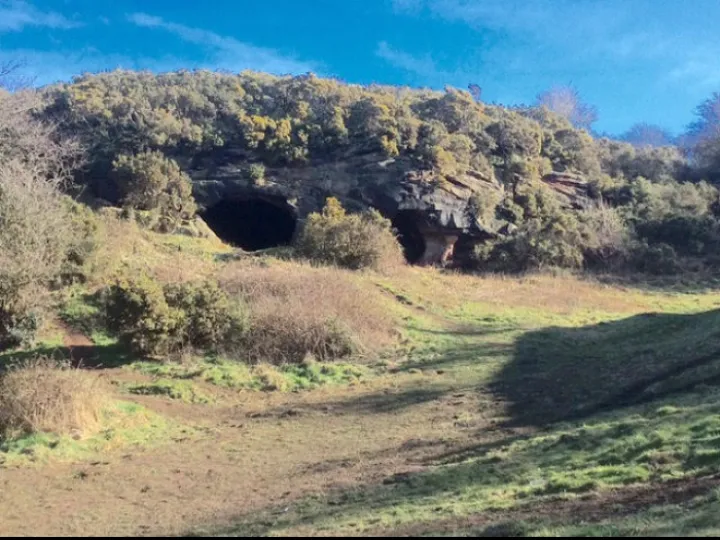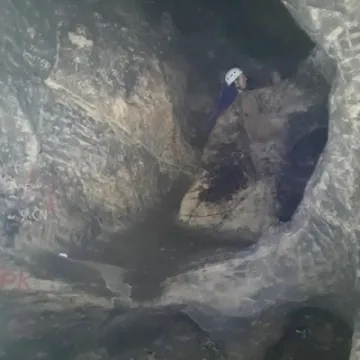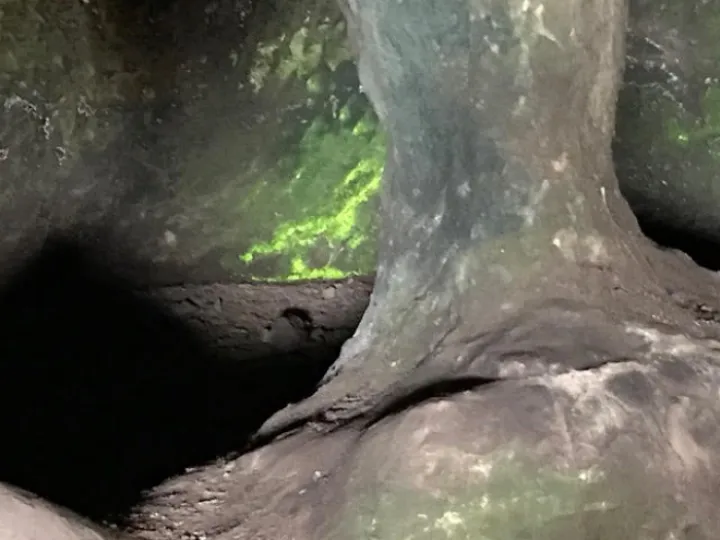Upton's Caves, Frodsham - Heritage on The Ridge
Of all the caves on the Sandstone Ridge, Upton's Caves are associated with the most stories and legends although they are barely remembered today. The name Upton is forgotten and the caves are generally known as the Frodsham or Overton Caves. They are easily accessed by the footpath that runs from Manley Road to Top Road and suffer frequent footfall from the public. Graffiti, campfires and litter are the result. It is to be hoped that some recognition and information about their history can help to preserve them for future
enjoyment.
Photo 1 – Upton's Caves
The 'Beneath the Ridge' project has identified three neighbouring sites that may be called caves or shelters although accounts from the nineteenth century would suggest that there were more. Some may have been lost through the extensive quarrying in the area. In a letter to the Nantwich Guardian (17/1/1880) the distinguished botanist, James F Robinson of Frodsham, wrote of legends associated with "the huge caverns found here and there scattered over the rocky crags".
In an earlier article written for the Cheshire Observer (10/8/1878) Robinson referred to the "old caverns" and wrote "the visitor who fails to visit these Fairy Caves before leaving the neighbourhood misses the grandest sight nature affords in these vast solitudes". He describes a "central cave" extending "some distance beneath the rocks" but also a neighbouring "Fairy Cave" associated with a legend concerning fairies spinning flax for an idle girl of the neighbourhood. Later he describes the place as "where the Fairy Caves are now opened out", so by his time there was probably only one substantial cave. Still today, it has more than one entrance (see photo) and it seems likely that the interiors of several smaller caves have been joined together. The location of Robinson's legends is clearly indicated by one tale of prehistoric savagery:
Long before the days of Julius Caesar's invasion of these islands, Overton Hill was occupied by a race of men of gigantic stature, who offered up their children as a burnt sacrifice to propitiate their gods. They did not worship idols, but had altars of stone on which the victims were offered. The chieftain's pillars or stones were in Upton's sand cave fields ... ({Nantwich Guardian 17/1/1880)}
We can take these legends with a large pinch of salt and the fact is that we cannot be sure of just how old these caves truly are. Whilst there may have been ancient overhangs and shelters caused by erosion, caves do not develop naturally in the interior of sandstone and so it is certain that Robinson's caverns had been extended considerably by the hands of workers in more recent times. And we know a little about what these workers were doing: they were mining sand.
Photo 2 – Interior of Upton's Cave
The earliest date to be inscribed in the cave itself comes from a piece of graffiti made by a J Harvey in 1838 (1). The interior shape of the roof, supported by pillars reflects the classic "pillar and stall" method of mining and scraping evident in caves throughout the length of the Sandstone Ridge. The sand excavated was of a very desirable white colour and had a variety of uses but was probably used in greatest quantity during the eighteenth century for spreading on and scouring cottage floors, a practice that lasted well into the nineteenth
century in rural areas and was probably only superseded by the invention of linoleum in the 1860s.
The name "Upton's Caves" seems to derive from a family who had owned the surrounding fields from at least 1842. The plot was occupied by James Upton, a farmer-cum draper from Manchester who died in Frodsham in 1852, but it was owned by his son William who had married well and was still the owner when the land was advertised for auction in April 1871:
In Lot 8 there are peculiar excavations or caves very attractive to the sight-seer on account of their quaintness: and as it commands most extensive and picturesque views and is well equipped with water, it presents a most desirable plot for the construction of pleasure grounds for excursionists.
William left Frodsham and ended his days in Prestwich, where he died in 1889. He was buried, however, in Frodsham. There is no evidence that he actually farmed there but in the 1880s, as Robinson testifies, the land was still known as Upton's Cave Fields. Other names have been associated with the caves. Dodd in The History of Frodsham and Helsby (1987, p.95), refers to local excursions to "Devil's Hole" and a report in the Ashton Weekly Reporter and Stalybridge and Duckinfield Chronicle (6/4/1867) about a trip to Frodsham, mentions a family who had been ejected from their cottage having "passed the winter (and a ruthless one it was) under the shelter of a natural hole in the rock, where they now resided, paying neither rates nor taxes..." Both may have been referring to Upton's Caves but the locations have not been verified.
The impression given by these and Robinson's accounts is that there was no extensive sand- mining conducted after the 1860s. Instead the caves were simply an object of picturesque interest and sight-seeing. They were also, in the last three decades of the nineteenth century, the occasional home of the vagrant artist "Old George Thompson" (2) . There are more recent accounts from people who used to play in the caves in the 1950/60s referring to the nicknames they gave various areas. One name crops up regularly, that is "The Pulpit", a raised platform in the deepest part of the caves.
Photo 3 – A Beneath the Ridge volunteer exploring The Pulpit
Sometimes the caves have been boarded up while at other times cattle have had free access to them with the inevitable consequences. Given the ill-treatment that the caves have received over the years it is remarkable that they still have one interesting tenant that should be seen and cherished: a rare and attractive moss called Goblin's Gold (Schistostega pennata). James Robinson claimed to be the first to identify it here:
The moment (the visitor) enters the larger cave, or the one in the centre, he is struck with the beautiful, vivid light, of an emerald hue, reflected from the summit and sides in the autumnal and especially in the winter months. It is very attractive as it has the appearance of a series of minute diamonds hung on the edge of the rocks. Upon close examination it is found to be caused by the small drooping leaves, or fronds of the Shining Cavern Moss (Schistostega pennata, L.), a very rare species, though it occurs here in considerable quantity. ({Cheshire Observer 10/8/1878).}
The moss has been identified in small quantities elsewhere on the Ridge. It specialises in darker places and appears luminous by reflecting light through a mechanism similar to cats' eyes. It is not always easy to spot and requires a certain amount of light for it to luminesce. A volunteer recently confirmed its presence at Upton's Caves and managed to photograph it – no easy feat in the semi-gloom:
Photo 4 – Goblin's Gold in Upton's Caves
The Trust would be interested to learn of any other sightings of this moss on the Ridge and would welcome any other contributions to the story of the Frodsham caves.
Much of this article is indebted to the research of local historian, Susan Lorimer.
Peter Winn, Trustee
Should you be thinking about entering Upton's Caves at Frodsham, please be advised that there has been a substantial rock fall from the cave ceiling during lockdown.
Click on each image to enlarge
(1)Graffiti is very unreliable but its position in the cave might give an indication of the minimum depth that
miners had reached by that date.
(2) For the history of Old George see the article on the Sandstone Ridge Trust's website (12/07/20): A Victorian
cave-dweller, George John Thompson (1834-1904) CLICK HERE

Sandstone Ridge Trust
Registered Company No. 7673603
Registered Charity No. 1144470
info@sandstoneridge.org.uk



